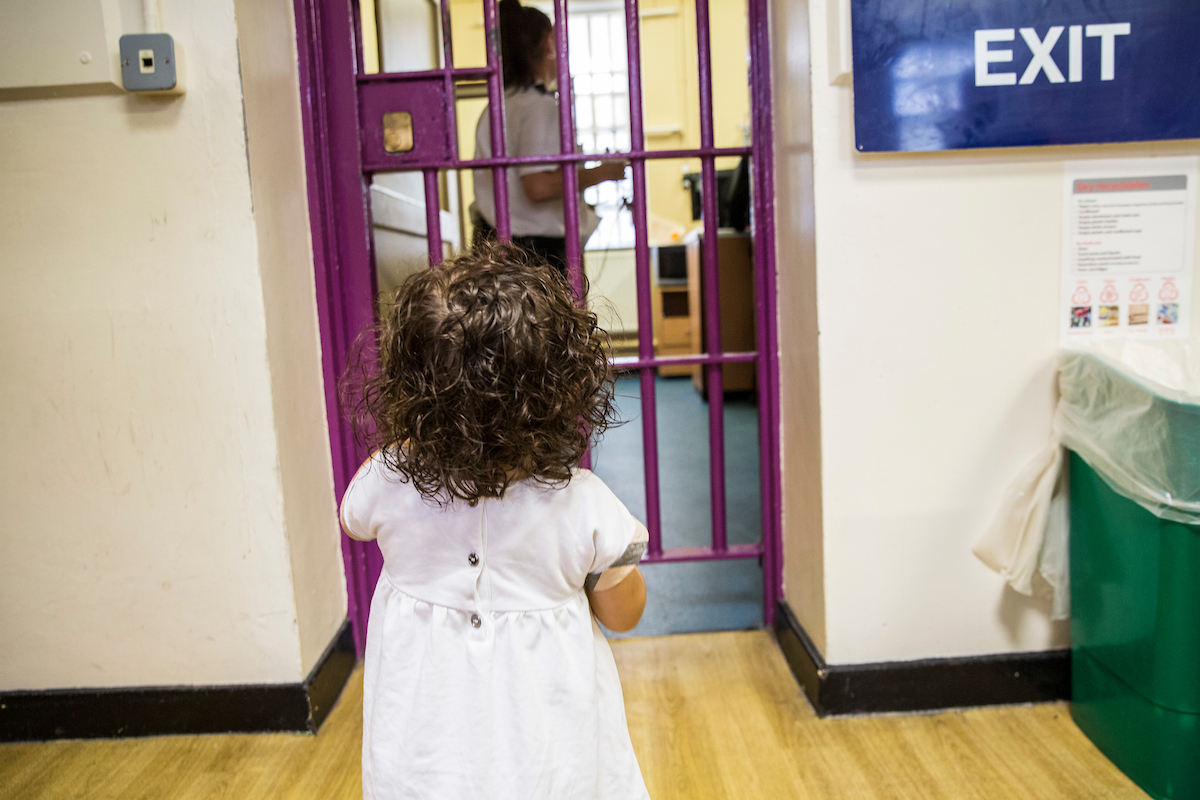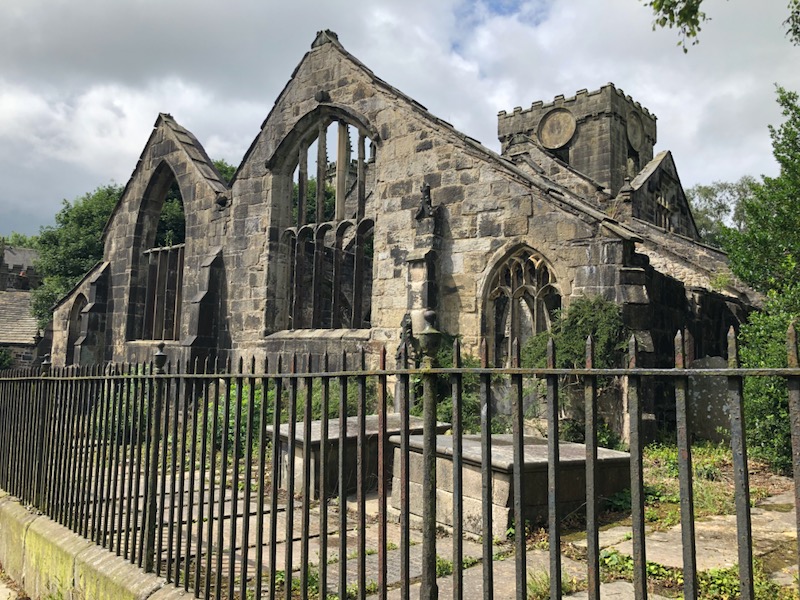HEPTONSTALL: A very handsome hill village of dark stone houses with all kinds of minor architectural surprises.” These words by Nikolaus Pevsner, the famous architectural historian, hit the nail on the head. Perhaps the greatest of the “architectural surprises” of this smart West Yorkshire village, perched on the moorland “tops” above bohemian Hebden Bridge, are its two churches. Both dedicated to a St Thomas, the older, the church of St Thomas the Martyr (a.k.a. Thomas Becket, archbishop of Canterbury, hacked to death in his own cathedral in 1170), has its origins in the thirteenth century and was ruined by a storm in the mid-nineteenth century. Deciding its repair wasn’t worth the trouble, the parishioners built a fine Victorian Gothic replacement a little to the south, which to distinguish from its predecessor, they dedicated in honour of St Thomas the Apostle. The churches stand side by side amidst a burial ground that local tradition claims is the resting place of 100,000 souls who lived and died in Heptonstall and surrounding its hamlets between the medieval and the modern.
The medieval church, which was founded as a chapelry of the vast parish of Halifax, some seven arduous miles away, is a low and broad structure with two naves and north and south aisles. It doesn’t take too practised an eye to descry evidence of the building’s Catholic past. A small bell-cote rises above the ruins of the chancel and originally would have housed the sanctus or sacring bell, rung when the priest standing at the altar beneath performed the miracle of Transubstantiation. The five consecration crosses, the number recalling the Wounds of Christ, etched into the altar stone can clearly be seen. In close proximity to the altar is the piscina. Here the priest washed the sacred vessels after Mass, its small drain soaking into the earth beneath, thus preventing any residual consecrated bread, wine or holy water being filched and used for sacrilegious or magical rites.
Topped with battlements, the rectangular western tower looks like the work of a castle architect rather than an ecclesiastical master mason. The tower’s lower stages have been dated to the thirteenth century but the upper storeys, like the rest of the ruin, are in the Perpendicular Gothic style of the decades either side of 1500. It’s a dating supported by documentary evidence, especially the wills of the late medieval Heptonstall faithful. In 1440 one William Brygge of Heptonstall bequeathed over £6 – then a substantial sum exceeding the annual stipend of most salaried clergy – for the “making” of the chapel’s bells. Building works were clearly underway in 1465 when local denizen Robert Shagh left approximately £3 for the “fabric” of the chapel.
Other bequests were towards the equipping and furnishing of the chapel. Members of the Grenewood family were especially generous benefactors. Thomas Grenewood left £4 in 1494 to buy a chalice, whereas in 1508, William Grenewood bequeathed a further £4, this time to buy a vestment. Equally generous was Robert Browne, chaplain, who in 1517 left twenty gold nobles, each worth six shillings and eight pence, for the purchase of a velvet cope. Three years later one William Sutcliffe provided the cash to buy an antiphonary, a book containing the sung portions of the Divine Office.
Evoking the intercession of the Blessed Virgin and the “holy company of heaven” these wills were accompanied by requests to be buried within the graveyard or the chapel itself, which became the sepulchre of the local gentry and yeoman elite. Their number included John Stansfield who died in 1508. In the eighteenth century, medieval glass painted with his family arms accompanied with the date “MDVIII” in Roman numerals could still be seen glazed in the chapel’s east window. The other medieval glazing included images of the Twelve Apostles and the “IHS” monogram, the key iconographic representation of the Holy Name of Jesus, was painted onto one of the pillars.
The religious horizons of the Heptonstall faithful extended beyond the boundaries of their hilltop village. Friars at Doncaster and Knaresborough, the guild of Saints Christopher and George in York and the hospital of St Antony in London, were all favoured with cash bequests. At least one son of Heptonstall answered the call of the cloister: Brother John Heptonstall (monks and nuns routinely took their place of origin as their surname after taking their monastic vows) was one of the last monks of Kirkstall Abbey, near Leeds. After the monastery’s suppression in 1539, he attempted to salvage a substantial portion of its library in the hope that the abbey would one day “go up again”.
This religious conservatism was shared by the villagers themselves. In 1536, money was left for the repair of the chapel’s rood loft, and well into the 1540s a steady stream of bequests was directed towards the chapel’s construction and beautification.
But within a generation, the winds of religious change swept through the village, establishing Heptonstall as a centre of hotter forms of Protestantism. Methodism reached the village in 1742 and John Wesley preached there on no fewer than five occasions. In 1764, work started on the construction of the octagonal chapel which is now the oldest continually used place of Methodist worship anywhere in the world.
Wesley was no fan of the medieval chapel, which by his time had been raised in status to a parish church, complaining in 1786 that it was “the ugliest I know.” A few years previously its clock had been seriously damaged by winds. Worse was to follow, a storm in 1847 causing such serious damage to the ancient structure that the local worthies opened a public subscription to build a replacement. An essay in Victorian Gothic ecclesiastical architecture, this was consecrated in 1854. Without its roof and stripped of its fittings, the medieval church rapidly fell into ruin, its choir as bare as that of any despoiled medieval monastery.
Today, the village’s principal claim to fame is arguably that Sylvia Plath, the American poet and novelist, lies buried in its churchyard. In 1956, Plath married local-boy Ted Hughes, the future Poet Laureate. Their tumultuous marriage ended in 1963 with her tragic suicide. Her grave has become something of a feminist shrine and pilgrimage destination with dead pens, drained of their ink, left in her memory. The name on the headstone reads “Sylvia Plath Hughes”. Modern secular iconoclasts have attempted to erase the final word, its faded presence a vivid reminder of the complexities of history.



 Loading ...
Loading ...
What do you think?
You can post as a subscriber user ...
User comments (0)